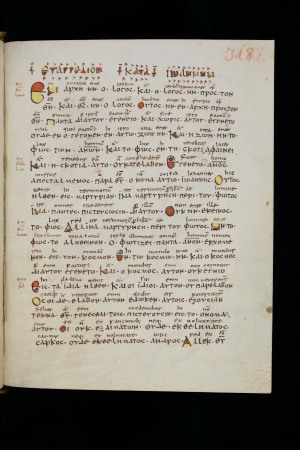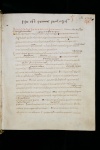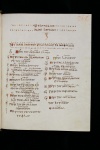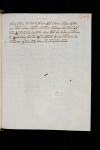Codex Sangallensis 48
From Textus Receptus
(→External links) |
(→See also) |
||
| Line 51: | Line 51: | ||
* [[List of New Testament uncials]] | * [[List of New Testament uncials]] | ||
* [[Textual criticism]] | * [[Textual criticism]] | ||
| - | |||
| - | |||
| - | |||
| - | |||
| - | |||
| - | |||
Revision as of 14:39, 6 January 2012

Codex Sangallensis, designated by Δ or 037 (in the Gregory-Aland numbering), ε 76 (von Soden), is a diglot Greek-Latin uncial manuscript of the four Gospels. Usually it is dated palaeographically to the 9th, only according to the opinions of few palaeographers to the 10th century.[] It was named by Scholz in 1830.[]
Contents |
Description
The codex contains 198 parchment leaves (actual size 23 cm by 18.5 cm). The text is written in one column per page, and 17-28 lines per page,[] in large semi-uncial letters.[]
The codex contains almost the complete text of the four Gospels with only one lacunae in John 19:17-35. The Latin text is written above the Greek (as Codex Boernerianus) and in the minuscule letters. It is decorated, but decorations were made by inartistic hand.[] It contains prolegomena, the Epistle of Jerome to Pope Damasus I, the Eusebian Tables, tables of κεφαλαια both in Greek and Latin, τιτλοι, Ammonian Sections, Eusebian Canons in Roman letters.[]sup>[]</sup>
The texts of Mark 7:16 and Mark 11:26 are omitted. The Pericope Adulterae (John 7:53-8:11) is omitted, but blanked space was left (for the pericope).
Text
The Greek text of the Gospel of Mark is a representative of the late Alexandrian text-type (similar to Codex L),[] and in rest of the gospels the Byzantine text-type (as in Codex Athous Lavrensis). Aland placed it in Category III.[]
- Textual variants
- In Matthew 27:35 it has additional phrase τα ιματια μου εαυτοις, και επι τον ιματισμον μου εβαλον κληρον together with codices: Θ, 0250, f1, f13, 537, 1424.
- In Matthew 1:12 it reads Ζορομβαβαβελ for Ζοροβαβελ.[]
- In Mark 4:19 it has unique variant η αγαπη του πλουτου (the love of wealth), other manuscripts have η απατη του πλουτου, απαται του πλουτου or απαται του κοσμου.[]
Latin text
The Latin version seems a mixture of the Vulgate with Old Latin Itala, and altered and accommodated to the Greek as to be of little critical value.
The interlinear Latin text of the codex is remarkable for its alternative readings in almost every verse, e.g. uxorem vel coniugem for την γυναικα in Matthew 1:20.[]
History
The codex was written in the West, possibly in the St. Gallen monastery, by Irish monk in the 9th century.[] It can not be dated earlier, because it has a references to the (heretical) opinions of Godeschalk at Luke 13:24, John 12:40.
It was examined by Gerbert, Scholz, Rettig, J. Rendel Harris. Rettig thought that Codex Sangallensis is a part of the same manuscript as the Codex Boernerianus.
The text of the codex was edited by H. C. M. Rettig in 1836, but with some mistakes (e.g. in Luke 21:32 οφθαλμους instead of αδελφους).[] There are references are made to the opinions of Godeschalk († 866) in Luke 13:24; John 12:40 and to Hand Aragon († 941).[] The Latin text in a major part represents the Vulgata.[]
The codex is located, in the Abbey library of St. Gallen (48) at St. Gallen.[]



